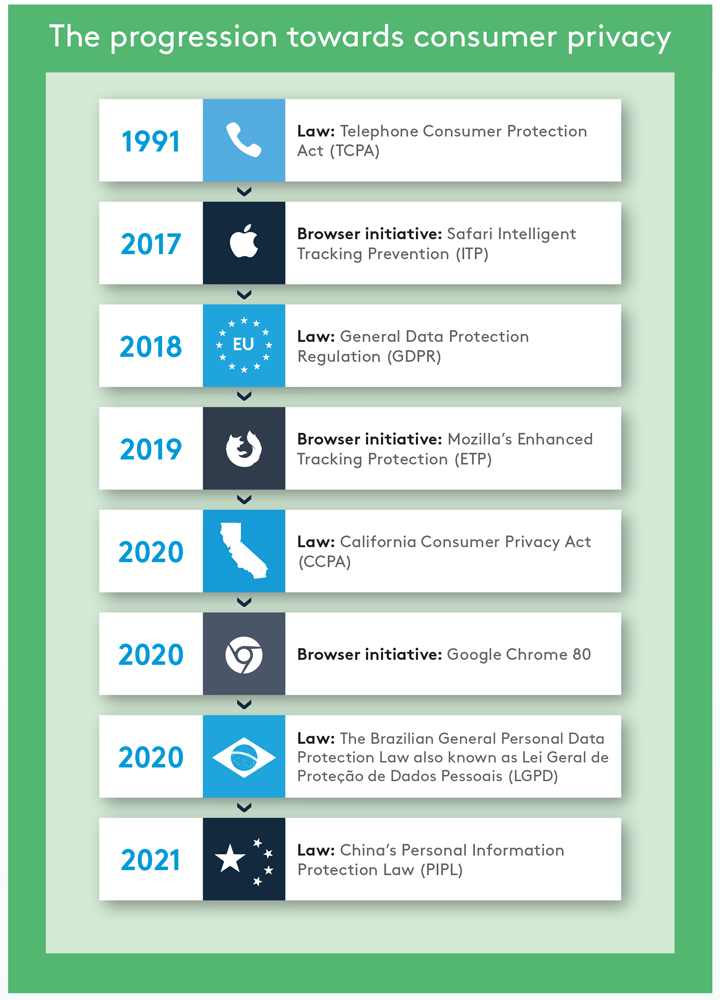The Cookieless Future: How to Maintain Accurate Measurement and Prioritize Consumer Privacy

Performance marketers are preparing for a cookieless future full of evolving consumer privacy regulations. This new wave of regulations is making marketers rethink how to maintain accurate measurement across their digital campaigns.
The impact? Affiliate networks that fail to prioritize privacy initiatives and adopt alternate tracking methods in lieu of cookie-based tracking will become obsolete.
Before we dive into the solution moving forward, let’s explore how we got to where we are today and the challenges that a cookieless future poses.
The cookieless future: How we got here

With the release of the 2018 General Data Protection Regulation (GDPR) in Europe, there has been a steady roll out of privacy initiatives.
While laws and web browser restrictions were enacted prior to the release of the GDPR, it was this regulation that served as the catalyst for consumer privacy to earn a prominent place in every marketer’s mind. In fact, more than 60 countries have followed the GDPR by creating or proposing other privacy laws.
Plus, browsers like Safari, Chrome, and Firefox regularly unveil more stringent tracking changes that block both first- and third-party tracking cookies in an effort to protect consumers online privacy. However, Chrome, the world’s leading internet browser, reversed its decision to eliminate third-party cookies in July 2024.
With these restrictions, measuring consumer interactions with marketing and advertising is getting more difficult, but it’s not impossible. Consumer privacy and accurate measurement can coexist to deliver a personalized experience for the end customer.
Now, let’s explore the challenges a cookieless future presents to performance marketers.
The cookieless future: The current challenges
As the digital world ventures into a future without cookie tracking, networks are faced with a few challenges from both the consumers they attract and the advertisers they partner with:
- Consumers are anxious about the lack of control they have over the information companies collect about them. Their demands are simple: (1) data collected should only be used to enhance the overall customer experience, and (2) personally identifiable information (PII) should be handled with extreme care.
- Advertisers fear an overall lack of control over their affiliate program performance in the face of frequent tracking policy updates. They’re looking for reassurance.
Affiliate networks must deliver on these requests. Fortunately, there is a solution.
Affiliate networks can ease consumer and advertisers’ worries by leveraging a modern tracking platform that provides transparency and optimizes performance while balancing consumer privacy.
The cookieless future: The solution
With the recent surge in web browser restrictions that impact cookie tracking, marketers are left with an incomplete view of performance. As a result, cookie tracking is far from being a best practice.
This is where alternate tracking methods come into play as they enable marketers to accurately measure campaign performance without third-party cookies.
Best approach: Server-to-server tracking using a postback URL
Most commonly known as “server-to-server,” but also referred to as “postback tracking,” this approach requires an advanced affiliate marketing solution that can assign a unique identifier (ID) to an anonymous consumer’s interaction.
In place of a cookie, a click ID or session ID can be stored server-side, or in the advertiser’s first-party cookie, until the point of conversion. At that moment the consumer’s click on the ad is attributed to their conversion via the unique ID. Since any measurement platform that supports this type of tracking will use its own unique IDs in place of cookies, it’s an increasingly popular approach to meet both performance tracking requirements and data privacy demands.
Plus, since server-to-server tracking does not rely on cookies that can be cleared by the consumer or blocked by customer browser settings, it’s a highly accurate approach for measuring performance.
Here is how server-to-server tracking works:

Alternate method: First-party session cookies with JavaScript SDK tracking
This approach is a hybrid of cookie and cookieless tracking and utilizes the unique ID mentioned in option #1 and a JavaScript SDK (an HTML conversion pixel), instead of a postback URL.
When used in conjunction with a click pixel, the JavaScript SDK (JSSDK) reads the unique session ID that is set in the first-party cookie by the click pixel and uses that value for the campaign attribution instead of the cookie.
Though this option is easier to implement than server-to-server tracking using postback URLs, it still requires the use of a first-party session cookie which is susceptible to browser restrictions. Also, note that it requires that you place a click pixel on the landing page of an offer in addition to the conversion pixel (JSSDK) on the thank-you page.
Alternate method: Fingerprint tracking
While first-party cookies and cookieless tracking can accurately measure performance the majority of the time, fingerprint tracking can be a helpful tool to supplement those efforts. It serves as a valuable strategy to ensure nothing slips through the cracks with the deterministic tracking methods you have in place, especially for areas such as the walled gardens and cross-device user behavior that can be difficult to measure with absolute certainty.
Also known as “session tracking” or “probabilistic tracking,” fingerprint tracking is a probabilistic approach to attributing customer actions back to digital advertisements the consumer interacted with. You can use this to achieve the best guess as to the performance of marketing campaigns and dollars.
Fingerprint tracking attempts to match consumers’ interactions with the ad to their conversion, such as a request for more information, through various attributes such as the device or browser used. It offers another privacy-friendly approach, as it’s not required to store any data that would risk consumers’ right to anonymity.
Get the eBook
Four Ways to Future Proof your Affiliate Network

Download our latest eBook to explore how performance marketers are navigating a new world without cookies plus additional ways to strengthen your affiliate network and the affiliate programs you manage in 2022 and beyond.
Explore other CAKE features:
- These 11 Affiliate Portal Features Will Help You Create a Great Experience for Your Affiliates
- Landing Pages: The Feature You Need to Streamline Workflows
- Five Reporting Features You Should Be Using in 2022